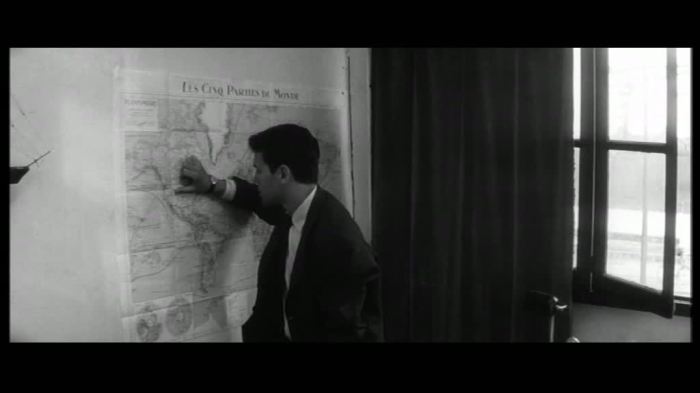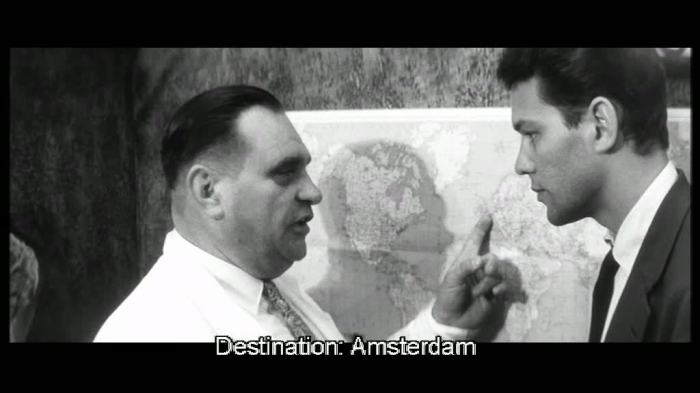 Lola is a sort of abstract ballet movie whose the scene is the town of Nantes. The film is about wait and boredom, planned departures and expected returns . There are two world maps in the film, both of them related to the character Roland Cassard. Both are a bit mysterious and fully cinematic. Both draw imaginary spaces, past and future, for the hero but also perhaps for the movie director.
Lola is a sort of abstract ballet movie whose the scene is the town of Nantes. The film is about wait and boredom, planned departures and expected returns . There are two world maps in the film, both of them related to the character Roland Cassard. Both are a bit mysterious and fully cinematic. Both draw imaginary spaces, past and future, for the hero but also perhaps for the movie director.
Lola est un film ballet dont la scène est la ville de Nantes. C’est un film sur l’attente et l’ennui, les départs envisagés et les retours espérés. On trouve deux planisphères dans le film, tous les deux liés au personnage de Roland Cassard. Tous les deux sont un peu mystérieux et très cinématographiques. Tous les deux dessinent des espaces imaginaires, passé et futur, du héros mais aussi peut-être du cinéaste.
Roland Cassard opens his old English dictionary at random and says : « like, Likely, likeness: ressemblance ». He approaches a world map on the wall and reads the name of two U.S. cities: Carson City and Salt Lake City, »Salt-Like » he mispronounces, as a sort of sound association. He presumably refers to his childhood since he tells later Ms. Desnoyers that his father, a sailor who died when he was five, took him on a trip to the U.S.. However, neither Carson City (Nevada) or Salt Lake City (Utah) are near the sea. At this little mystery echoes the remark of Ms. Desnoyers to her daughter when Cecile told her she just met a sailor from Chicago, Illinois: « If you knew your geography, my poor child, you would know that there are no sailors but gangsters in Chicago! ».
And yet it is precisely a gangster that Cassard meets in front of the second world map of the movie. The barber looks like a killer of a Film Noir and his shadow projected on the maps covers precisely the United-States while his finger points at the Netherland. He offers Cassard a mission to Johannesburg via Amsterdam that later will appear to be related to diamond trafficking (the first title of the movie was « a Ticket to Johannesburg »). Cassard agrees first, then changes his mind and eventually decides to accept the mission. The character Roland Cassard appears in Les parapluies de Cherbourg, the next movie of Demy. He now works in Amsterdam in trade of precious stones.
Another place, more exotic and not written on a map but on a movie poster, gives the film another cardinal point and provides us a new geographic key. Michel had left Lola and their little boy Yvon to make a fortune. He first went to Matareva, Samoa. Lola does not have any news but she still hopes her lover will return. She sleeps with an American sailor, who reminds him of Michel, who had disguised himself as a sailor when they first met. But Matareva is also the island where the story of Return to Paradise happens. It is a film with Gary Cooper that Cassard sees at the theater in the afternoon. Lola has also a picture of Gary Cooper, hung on the screen near her bed. Early in the film, Michel returns, dressed in white as the sailors that wander around town. He almost run over some of them with his beautiful American brand new car and they shout at him « Cowboy ! ». Hence we understand that Michel/Gary Cooper is the sailor/cowboy who might as well be back from Carson City or Salt Lake City, these Western towns, like the father that Roland Cassard waited vainly when he was the age of Yvon.
We know that Lola is a ballet that draws a magical geography of Nantes (read this article by Gérard Lefort – in French). But the film goes further. It diffracts the space between reality and cinema. The geography of the film is no longer recognizable, despite Ms. Desnoyers statement. Geographic space becomes strange and unpredictable. Nantes, a town of sailors, is a town of gangsters as well, like Chicago, but also a town of cowboys like Carson City. Anyway, cowboys and sailors are the same and when « you leave for Marseille », « you arrive to Argentina! ». Roland Cassard is bored and a bit lost in Nantes. His life is up in the air, between a childhood that has vanished and a future that does not emerge clearly. Each world map of the movie points to a different direction. One to his past (1) and the other to a possible destiny. But both maps open up also two imaginary and cinematic spaces : Western, between Carson City and Salt Lake City, and Adventure film, between Amsterdam and Johannesburg. As states the bartender : « In the movies, all is always more beautiful. »
(1) The reality of the stay of Roland Cassard as a child in Nevada and Utah remains unresolved. His faulty pronunciation of Salt Lake City leaves a doubt. As Roland Cassard is also partly Jacques Demy himself, the reference to the American West could be only cinematic. Maybe Cassard as a little boy is dreaming to his father as a cowboy in the same way the character Jacques l’Aumône invents himself different possible futures in Raymond Queneau’s novel Loin de Rueil.
Français
Après avoir ouvert au hasard son dictionnaire d’anglais et prononcé les mots » like, likely, likeness : ressemblance », Roland Cassard s’approche d’un planisphère et énonce le nom de deux villes des Etats-Unis : Carson City et Salt-Lake City, qu’il prononce Salt-Like, comme une association sonore. On comprend ensuite qu’il se réfère vraisemblablement à son enfance puisqu’il dira plus tard à Mme Desnoyer qu’a l’âge de cinq ans, le père marin qu’il a perdu ensuite, l’a emmené en voyage aux Etats-Unis. Or ni Carson-City (Nevada) ni Salt-Lake City (Utah) ne sont pourtant des villes maritimes. A ce petit mystère fait écho la remarque de Mme Desnoyer à sa fille, quand celle-ci lui dit que le marin qu’elle vient de rencontrer est de Chicago, Illinois: « Si tu connaissais ta géographie, ma pauvre enfant, tu saurais qu’il n’y a pas de marins à Chicago mais des gangsters ! »
 Or c’est justement un gangster que Cassard rencontre devant la deuxième carte du film. Le coiffeur a le physique d’un tueur de film noir et son ombre projetée sur la carte couvre justement les Etats-Unis tandis que son index pointe la hollande. Il propose à Cassard une mission louche à Johannesbourg via Amsterdam qui se révélera ensuite être un trafic de diamants (le premier titre du film était » Un billet pour Johannesbourg ».). Cassard accepte puis se ravise mais finit par partir. On retrouvera d’ailleurs le personnage dans le film suivant de Demy, Les parapluies de Cherbourg, travaillant à Amsterdam dans le commerce de pierres précieuses.
Or c’est justement un gangster que Cassard rencontre devant la deuxième carte du film. Le coiffeur a le physique d’un tueur de film noir et son ombre projetée sur la carte couvre justement les Etats-Unis tandis que son index pointe la hollande. Il propose à Cassard une mission louche à Johannesbourg via Amsterdam qui se révélera ensuite être un trafic de diamants (le premier titre du film était » Un billet pour Johannesbourg ».). Cassard accepte puis se ravise mais finit par partir. On retrouvera d’ailleurs le personnage dans le film suivant de Demy, Les parapluies de Cherbourg, travaillant à Amsterdam dans le commerce de pierres précieuses.
Mais c’est un autre lieu plus exotique et marqué non pas sur une carte mais sur une affiche de cinéma, qui trace un deuxième point cardinal du film et nous offre une autre clé géographique. Michel a abandonné Lola et leur petit garçon Yvon pour faire fortune. Il a d’abord échoué à Matareva, aux îles Samoa. Lola espère toujours le retour de Michel. Le marin américain, avec lequel elle couche lui rappelle son amour enfui, qui était justement déguisé en marin lors de leur première rencontre. Matareva, c’est aussi là que se passe Retour vers le Paradis, le film avec Gary Cooper que Cassard va voir au cinéma l’après-midi où il est licencié. Or c’est bien une photo de Gary Cooper que Lola a accrochée à son paravent au-dessus de son lit. Michel revient, habillé de blanc comme ces marins qui parcourent la ville et qu’il manque écraser au début du film avec sa belle voiture américaine toute neuve. Ceux-ci le traitent de « cow-boy » et dès lors tout s’éclaire. Michel/Gary Cooper, ce marin/cow-boy pourrait aussi bien venir de Carson-City ou de Salt-Lake City, villes de western, comme ce père dont le petit Roland Cassar, à l’âge d’Yvon, attendit en vain le retour.
On sait que Lola est un ballet qui trace une géographie enchantée de Nantes (voir cet article de Gérard Lefort). Mais le film va plus loin. Il diffracte l’espace entre réalité et cinéma. Les figures du grand écran envahissent les rues. Nantes, ville de marins, est aussi une ville de gangsters, comme Chicago, et même une ville de cow-boys comme Carson-City. Géographie et le cinéma, c’est tout comme. Mais la géographie du film n’est plus reconnaissable, n’en déplaise à Madame Desnoyer ; elle prend un tour magique et imprévisible. Les cow-boys y sont des marins et quand « on part pour Marseille », « on se retrouve en Argentine ! ». Roland Cassard s’ennuie à Nantes. Il est un peu perdu. Sa vie est en suspens, entre une enfance qui s’éloigne et un futur qui tarde à se dessiner. Chacune des cartes lui indique une direction. L’une vers son passé (1) et l’autre vers un destin possible. Mais elles ouvrent en même temps sur deux espaces imaginaires et cinématographiques: celui du western, entre Carson-City et Salt-Lake-City, et celui du film d’action, entre Amsterdam et Johannesburg. Car, comme le dit la tenancière du bar, « au cinéma, c’est toujours plus beau ».
(1) Le caractère réel du séjour au Névada et en Utah de Roland Cassard enfant n’est pas tranché. Sa prononciation fautive de Salt-Lake-City laisse subsister un doute. Comme Roland Cassard est aussi pour partie Jacques Demy lui-même, il est possible que la référence à un Ouest américain soit uniquement cinématographique, et que le petit Cassard s’invente un père cow-boy comme le personnage de Jacques L’Aumône dans le roman Loin de Rueil de Raymond Queneau rêve ses avenirs possibles.
- Work Title/Titre de l’oeuvre: Lola
- Author/Auteur : Jacques Demy
- Year/Année : 1960
- Field/Domaine : Cinema
- Type : Comedy/Drama
- Edition : Georges de Beauregard
- Language/Langue:Fr
- Machinery/Dispositif : maps/cartes
- Location in work/localisation dans l’œuvre : 19:45,26:45,
- Geographical location/localisation géographique : Nantes, France #La Baule, France #Cherbourg, France #Carson City, Nevada #Salt-Lake City, Utah
- Remarks/Notes :
Pingback: Maps of Hitler / Les cartes d’Hitler. Der Untergang/Downfall/La Chute | (e)space & fiction
Pingback: Des chambres en ville. Agnès Varda « (e)space & fiction
Pingback: Le Nantes de Jacques Demy « (e)space & fiction